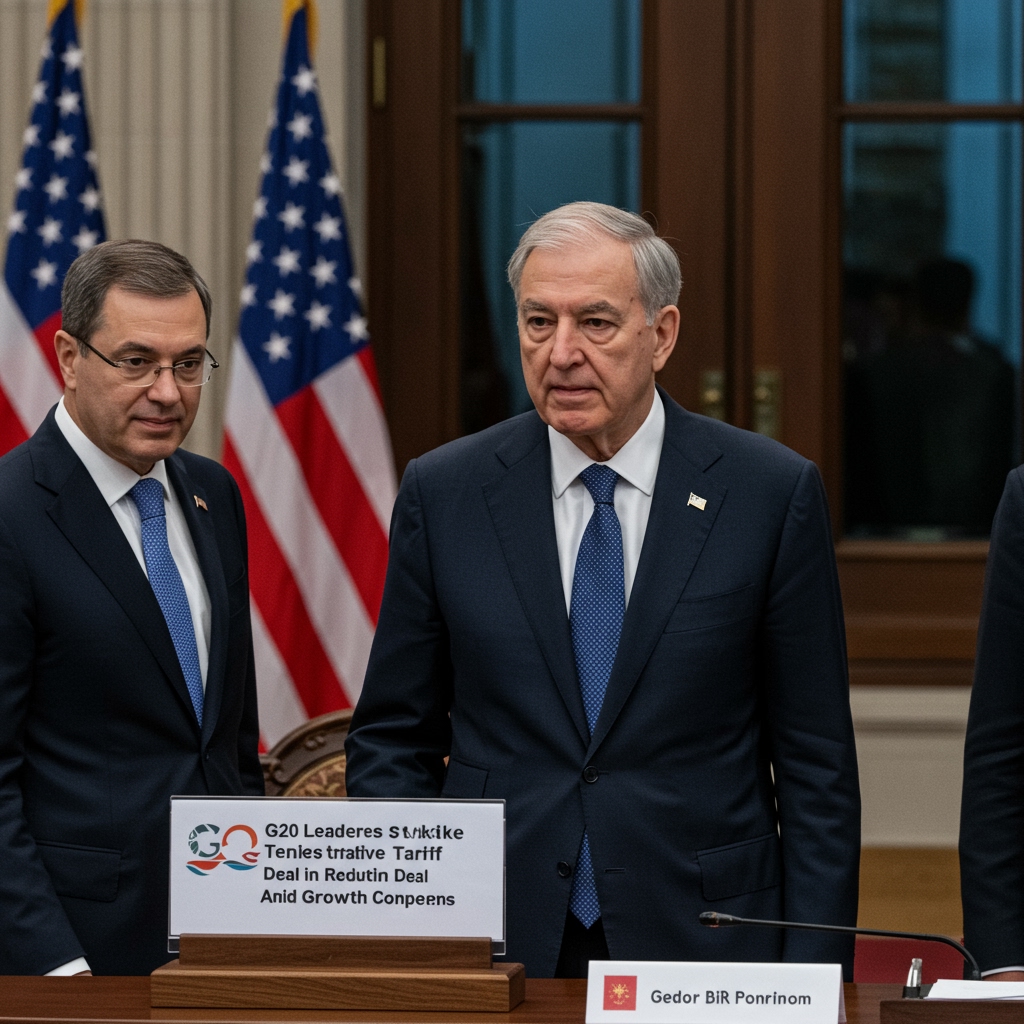G20 Nations Reach Tentative Tariff Agreement in Geneva
Geneva, Switzerland – Delegations from the G20 nations, representing the world’s leading economies, have announced a significant development on the final day of their three-day summit here in Geneva. A tentative agreement has been reached regarding substantial tariff reductions on a range of key industrial goods. This pact is explicitly aimed at counteracting the recent surge in protectionist trade policies observed globally and bolstering global economic growth prospects, which the International Monetary Fund (IMF) recently revised downwards for the year 2025.
Breakthrough After Stalled Negotiations
The consensus, while still pending final detailed formulation and formal ratification, marks a critical breakthrough following months of protracted and often stalled negotiations between major global trading blocs. Tensions between key players, most notably the United States and the European Union, had previously hindered progress on multilateral trade liberalisation initiatives. The G20 summit in Geneva provided the necessary high-level platform and concentrated diplomatic effort to bridge some of these divides.
Sources close to the negotiations indicated that the agreement’s framework emerged from intensive, late-night discussions, underscoring the urgency felt by member states to address the darkening global economic outlook. The downward revision of the 2025 growth forecast by the IMF served as a stark reminder of the potential economic costs of trade friction and highlighted the need for coordinated action to stimulate commerce and investment.
Addressing Rising Protectionism
The stated primary objective of the tentative tariff reduction agreement is to directly confront the trend of rising protectionism that has manifested in various forms, including increased tariffs, non-tariff barriers, and inward-looking trade policies adopted by several nations in recent years. Proponents of the deal argue that reducing tariffs on industrial goods will lower costs for businesses and consumers, foster greater international trade flows, and encourage more efficient global supply chains. The focus on key industrial goods suggests an effort to target sectors deemed critical for manufacturing, infrastructure development, and technological advancement across member economies.
While specific sector-by-sector tariff schedules and phase-out timelines are still under negotiation and subject to technical review, the agreement’s intent is clear: to reverse the protectionist tide and inject greater certainty and predictability into international commerce. A senior delegate, speaking anonymously, referred to the pact as a “cornerstone for renewed global economic cooperation in a challenging era.”
Economic Growth Implications
The potential impact on global economic growth is a central theme of the agreement. By reducing trade barriers, the G20 nations hope to unlock new market opportunities for businesses, stimulate exports, and encourage cross-border investment. This renewed dynamism is intended to help counter the factors that led the IMF to lower its 2025 growth projections. Economists have long argued that trade liberalisation is a powerful engine for growth, particularly in fostering innovation and increasing productivity.
Analysts widely view the agreement as a positive step towards stabilizing international commerce. Dr. Evelyn Reed, a trade policy expert observing the summit, commented, “This tentative deal sends a crucial signal that the major economies are willing to return to the table and find common ground on trade. After months of impasse, this consensus is genuinely encouraging, particularly for sectors reliant on international supply chains.”
Challenges Remain: The Ratification Hurdle
Despite the optimism surrounding the agreement, significant challenges lie ahead. The most prominent hurdle is the requirement for ratification in the national legislatures of the G20 member states. Trade agreements, even tentative ones reached at high-level summits, often face domestic opposition from industries concerned about increased foreign competition or from political factions advocating for protectionist measures.
Legislative approval processes vary widely across the G20 nations, involving potentially lengthy debates, committee reviews, and votes that could see the agreement amended or even rejected. Analysts caution that the tentative nature of the pact means that the fine print will be intensely scrutinised, and national interests could still derail the final implementation. Lobbying efforts from specific industrial sectors that might be negatively impacted by lower tariffs are anticipated.
“The real work begins now, back in the capitals,” stated Mark Jenkins, a trade consultant following the summit. “Securing a consensus in Geneva is one thing; navigating the complex political landscapes for ratification in two dozen different legislatures is quite another. There will undoubtedly be resistance from certain quarters.”
Next Steps and Future Outlook
The G20 delegations will now return to their respective countries to review the tentative agreement’s details and begin the process of preparing it for formal signing and legislative review. Technical working groups are expected to continue refining the specifics of the tariff reduction schedules and implementation mechanisms.
The successful conclusion of this round of talks in Geneva provides a renewed sense of momentum for multilateral trade discussions. It suggests a potential pivot away from the unilateral actions that have characterised trade relations in recent years towards a more collaborative approach. While the path to full implementation is fraught with potential obstacles, the tentative agreement reached by G20 nations on significant tariff reductions for key industrial goods represents a critical and potentially transformative moment for global trade, offering a beacon of hope for a more stable and prosperous international economic future, especially in light of the revised 2025 growth forecasts.





